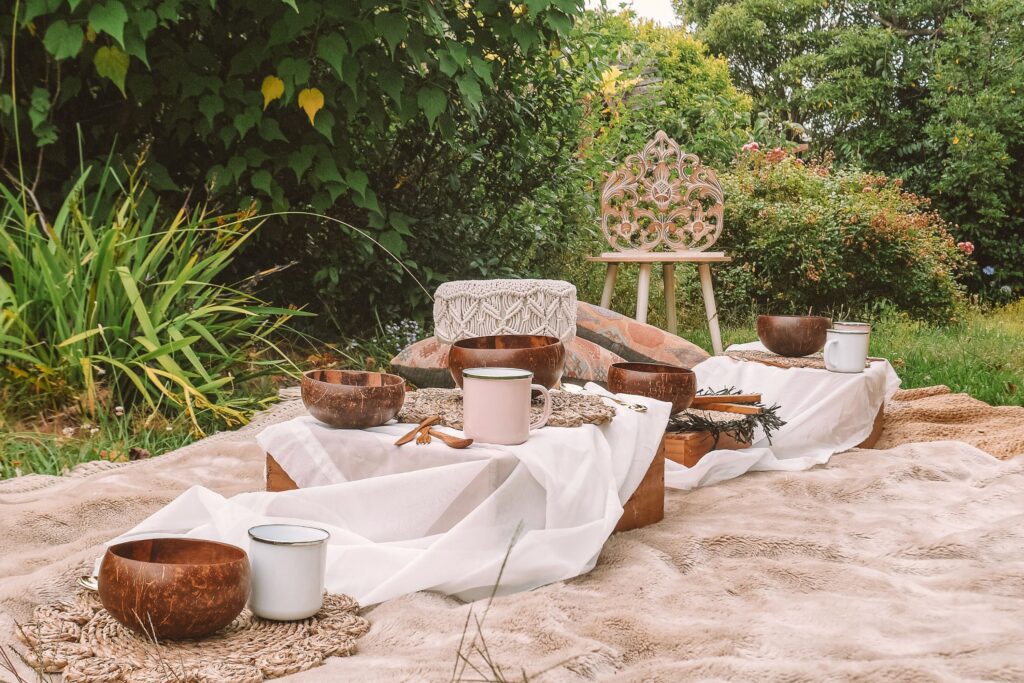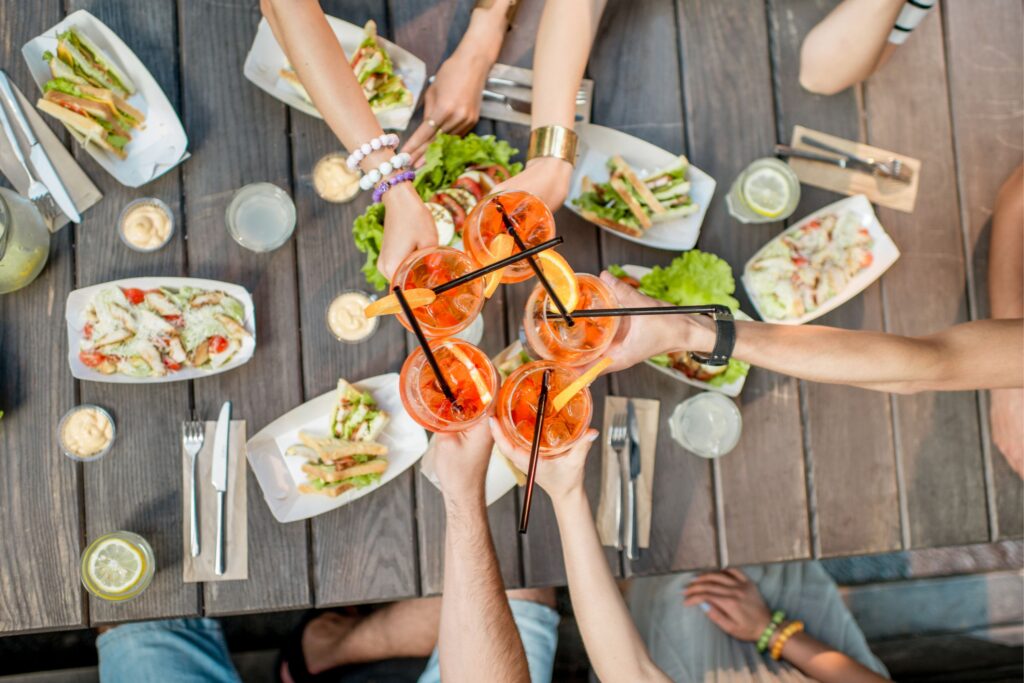When you picture a picnic, your mind might jump to a red-checkered blanket on green grass, maybe a wicker basket filled with sandwiches and fruit. That scene fits a traditional Western idea of picnicking. But the reality is, picnics don’t look the same everywhere.
Before examining how traditions vary, it helps to pause and consider what a picnic is—at its core, it’s a meal shared outdoors, often informal, and shaped by the environment and the people enjoying it.
Each culture brings its flavor—literally and socially—to the outdoor dining experience.
Some prefer structured picnics with portable tables and wine glasses, while others lean toward relaxed floor mats and shared platters.
The location might be a meadow, a temple courtyard, a riverbank, or even a rooftop. If you’re curious about how different parts of the world approach this simple joy of eating outdoors, this blog will give you a complete picture.
How Culture Shapes the Idea of a Picnic
Food traditions, social values, and climate all shape how people picnic. What works in Tokyo might feel out of place in Tuscany, and what’s common in Cape Town might seem unusual in Quebec. Culture defines not just what’s eaten, but how it’s served, who’s invited, what people wear, and even the time of day picnics usually happen.
In Japan, for example, picnics are deeply tied to nature and seasonal events. Hanami, the cherry blossom viewing season, brings people together under flowering trees. You’ll see families and coworkers sitting on blue tarps, sharing bento boxes filled with artfully arranged food. Everything is neat, coordinated, and thoughtful.
Meanwhile, in the Middle East, picnics often revolve around large gatherings with grilled meats, fresh bread, and long, social conversations. People might bring hookahs, carpets, and meals to set up in parks or deserts.
Why Cultural Variations in Picnics Matter
Understanding the cultural variations in picnics goes beyond food—it gives insight into how people connect with nature, family, and leisure. Picnics are usually big, multi-generational affairs in places where family bonds are central.
In countries where individualism or convenience matters more, people may picnic in small groups or solo, with simple, pre-packed meals.
When you travel and see how people picnic, you witness a quiet but revealing part of their cultural identity. It shows how much they value time outdoors, how they celebrate food, and how they socialize.
Climate and Geography Influence Picnic Styles
What people pack and how they set up a picnic also depends on where they are. A picnic in a humid tropical country will look very different from one in a cool mountain town. In Southeast Asia, you’ll often find picnics happening early in the morning or near sunset to avoid the heat. Shade, water access, and airflow are crucial.
In Scandinavian countries, where summers are short and sweet, people go all-in during picnic season. It’s not just about the food—it’s about savoring sunlight and warmth while it lasts. Snickers carry foldable chairs, coolers, and portable grills into the forest or by a lake.

How Religion and Tradition Shape Outdoor Eating
Another key aspect of cultural variations in picnics involves traditions and religion. Some cultures use picnics as a part of religious festivals or rituals. In India, many Hindu families bring food to temples or riversides during holy days, where the meal becomes both a spiritual and social moment. The food is vegetarian, shared communally, and often includes sweets and rice-based dishes.
Easter picnics are popular in Orthodox Christian countries, especially in rural areas. After attending religious services, people prepare and enjoy rich dishes in large groups. These meals may include grilled lamb, dyed eggs, and homemade wine. It’s about connection, celebration, and respecting long-held customs.
When to Picnic: Time and Occasion Vary by Country
In some cultures, picnics happen around specific events. In South Korea, school picnics are part of the calendar, and students bring homemade lunches or order food for class trips to nature parks. In France, casual picnics by the Seine or in vineyard regions often accompany festivals, family outings, or even romantic dates.
Meanwhile, Australians might pack up the car for a beach barbecue picnic that stretches the whole afternoon. Long weekends, national holidays, and even casual Sundays are perfect for throwing something on the grill and relaxing outdoors with a cold drink. There’s no rule—it’s all about what’s meaningful or convenient in the local lifestyle.
Food Traditions That Define Each Picnic Style
What you eat on a picnic says a lot about your culture. In the United States, sandwiches, chips, and soda seem like a basic combo, but it reflects the value placed on convenience and portability. In contrast, in places like Lebanon or Turkey, a picnic often involves rich homemade dishes—like tabbouleh, stuffed grape leaves, or grilled kebabs—served warm and shared family-style.
These aren’t quick meals. They’re slow, generous, and made for conversation. You don’t rush through a picnic like that. You linger, refill your plate, and enjoy the setting as much as the food. These details show how cultural variations in picnics mirror wider food habits and priorities.
Social Norms Around Picnicking
How people behave during a picnic can also vary from place to place. In countries like Germany or Switzerland, planning a picnic with attention to tidiness, order, and practicality is common. People often bring reusable containers, foldable gear, and mini recycling bags. It’s an extension of social values like sustainability and respect for public space.
On the other hand, in more communal societies like those in parts of Africa or South America, picnics are loud, lively, and open. Music is common. Neighbors might join in. No one worries too much about keeping things quiet or contained. The joy of being together is more important than sticking to rules or schedules.
If you’re traveling and hoping to picnic like a local, paying attention to these cues will help you blend in. Observing how people sit, share food, and interact can make your experience smoother and more respectful.

Celebrations That Include Picnicking
In some places, picnics are tied to specific holidays or public traditions. During Songkran (the water festival) in Thailand, people travel to their hometowns and gather with family, sometimes by rivers or under trees, sharing meals on mats. The feast often includes watermelon, sticky rice, and grilled fish.
Día del Campo (Day of the Countryside) celebrates rural life in Mexico. Schools or communities organize outings that include food, games, and dancing. It’s not a picnic in the traditional sense, but the concept—eating outside in a relaxed setting with others—is right there.
These events show that cultural variations in picnics aren’t just about food—they’re deeply woven into annual rhythms, weather patterns, and generational customs.
Gender Roles and Division of Labor
In some cultures, picnic food preparation and serving follow traditional gender roles. In places where these roles are more rigid, women might be responsible for preparing all the meals, packing everything, and setting up. Men might be expected to handle grilling or heavier lifting. This dynamic is at play in parts of Eastern Europe, Central Asia, and the Middle East.
But this isn’t always the case. In Scandinavian countries, gender roles tend to be more balanced. Men and women might cook together or take turns leading the meal. Modern picnics are often more equal in urban settings worldwide, with shared responsibilities and contributions.
This aspect of picnic culture reflects bigger social shifts and also influences the tone of the outing itself. A picnic where everyone pitches in creates a different atmosphere than one where a few people do all the work.
Tableware, Tools, and Setups Reflect Culture Too
Even the gear people bring to a picnic reflects their culture. In Korea or Japan, picnic setups often include perfectly portioned meals in stackable bento boxes. Everything fits just right, and cleanup is quick. People can bring wet towels, paper fans, or umbrellas to stay cool and tidy.
By contrast, in the Mediterranean region, you might find a more rustic setup—clay plates, cloth napkins, and glass containers carried in large totes. The goal here is less about precision and more about enjoying food at its best with minimal fuss. Some families even bring entire tablecloths, real cutlery, and portable wine holders.
These details may seem small, but they reveal how much thought different cultures put into outdoor dining. They’re also practical tips for travelers who want to prepare for a picnic abroad.
Attitudes Toward Public Spaces and Picnicking
Cultural differences in how public spaces are used also shape picnicking styles. In countries like the Netherlands or Denmark, there’s a strong respect for communal areas. Parks are clean, well-kept, and accessible, and people tend to keep their picnics low-key and orderly. There’s a shared understanding that everyone should be able to enjoy the space.
Compare that with parts of Latin America, where public gatherings are more spirited. A picnic might come with loud music, impromptu dancing, and a rotating cast of family and friends dropping in. It’s less about solitude and more about celebration. These contrasting norms show how deeply national attitudes toward personal space, noise, and group dynamics influence cultural variations in picnics.
If you’re visiting a new country and thinking of organizing a picnic, it helps to look around and see how locals use shared areas. It’s not just about rules—it’s about fitting into the rhythm of the place.
Urban vs. Rural Picnic Traditions
The difference between a city picnic and a countryside gathering isn’t just about location—it’s often about culture. Picnics are compact and efficient in large cities like Paris, London, or Tokyo. People bring what’s easy to carry, find a patch of green, and settle in for a few hours. Food is often store-bought, and drinks are chilled using portable coolers or ice sleeves.
In contrast, rural picnics in regions like southern Italy or northern India are usually planned events. Families may drive out to the countryside with homemade dishes, folding furniture, and even table decorations. There’s more space, more time, and often, more food. These settings offer a deeper look into local traditions and how they’re preserved outside of fast-paced urban life.
Understanding this urban-rural divide helps explain another layer of cultural variations in picnics, not just what people eat or where they go. It’s how long they stay, what they bring, and how they relate to the experience.
Music, Games, and Entertainment Traditions
Picnics aren’t only about food. In many cultures, they also offer a chance to enjoy games, music, and informal performances. In Brazil, a picnic might include samba music on a speaker while children kick around a ball. In India, card games and storytelling are part of the routine. In the United States, people might toss a frisbee, play cornhole, or set up Bluetooth speakers for some background music.
In some Asian cultures, picnics may be quieter, with board games, sketching, or silent reading more common. Entertainment styles reflect values like modesty, privacy, or extroversion. Knowing these preferences can help you choose what to bring or leave behind if you join a local group picnic while traveling.
Seasonal Picnicking Habits
The time of year also significantly influences how different cultures approach picnics. In Japan, spring is the highlight, with the hanami season drawing huge crowds to parks. In the UK, summer weekends are prime picnic territory, often with people staking out spots in Hyde Park or on the South Bank. In colder regions like Canada or northern Europe, picnicking is a brief, treasured part of late spring and early autumn.
Meanwhile, in countries with milder or tropical climates, like Indonesia or Kenya, picnics may happen year-round, although people plan around rain and heat. In desert regions, night picnics are popular to avoid the blazing sun. These seasonal variations show how climate blends with custom to shape outdoor dining traditions.
The Role of Language and Naming
Different cultures refer to outdoor meals differently, reflecting how they view the picnic experience. In French, it’s pique-nique, suggesting something light, casual, and social. In Arabic-speaking regions, the word might simply mean a day trip or outing (rahla), where eating is only part of the overall experience.
In some countries, the term “picnic ” does not have an exact translation, but the concept still exists under another label. It could be tied to religious rituals, a seasonal outing, or a weekend gathering. This variation in naming shows how cultural variations in picnics go beyond what people do—they affect how people think.
Street Food Culture and Its Connection to Picnics
In many places, picnicking naturally blends with local street food habits. In Thailand or Vietnam, for example, it’s common to pick up meals from roadside vendors and find a shady spot near water or a public park to enjoy them. People don’t need to pack food ahead—they adapt by using what’s fresh and accessible nearby.
This flexible approach to picnicking appears in cities around the world. Whether it’s falafel in Tel Aviv, bánh mì in Ho Chi Minh City, or tacos in a Mexican plaza, the idea is the same: enjoy good food outside without overthinking it. It proves that cultural variations in picnics also reflect how people interact with food daily.
Blending Traditions in Multicultural Cities
You’ll notice something special in multicultural cities like London, Toronto, or Melbourne. People from different backgrounds picnic side by side, often blending traditions creatively. One group might be grilling jerk chicken, another shares sushi, and a third enjoys homemade pasta and wine.
This fusion reflects a city’s cultural openness. It’s not about following one strict picnic formula—it’s about bringing what feels familiar and sharing it. Over time, these interactions build new local habits. In places like this, you’ll see cultural variations in picnics evolve right before you, shaped by migration, curiosity, and community life.
What Cultural Variations in Picnics Teach Us
Exploring picnic styles worldwide reveals something essential but straightforward: outdoor meals are never just about eating. They reflect how people connect with nature, prioritize community, and pass on traditions through everyday pleasures. The blanket, the basket, and the view may change, but coming together over food is universal.
By understanding these cultural variations in picnics, you’ll start noticing the small things that make each experience unique. The kind of food packed, the way people sit and serve, and even the music playing in the background aren’t random details. They are cultural fingerprints. Whether planning your picnic abroad or joining locals, noticing those differences will make the experience more meaningful.
If you love travel and food, learning about picnic traditions is an easy, enjoyable way to understand the places you visit. Start by observing. Then try adapting. Over time, you may rethink how you picnic at home, too.
FAQs
What are some examples of cultural variations in picnics?
Different cultures focus on various foods, group sizes, and picnic settings. For example, Japanese picnics during cherry blossom season feature bento boxes and shared mats, while Middle Eastern ones often include grilled meats, carpets, and tea.
Do all cultures use the term “picnic”?
No. Some cultures don’t use a direct translation of “picnic.” Instead, they associate the practice with outings, festivals, or religious days where food is enjoyed outdoors.
How does the weather influence picnic traditions?
Climate affects the time of day people picnic, the foods they bring, and how long they stay. In hotter regions, people often picnic in the evening or under shade. In colder places, picnicking is seasonal and usually brief.
Are there differences in how people clean up after picnics?
Yes. In cultures with strong environmental norms, like in Nordic countries, people are diligent about cleaning up and sorting waste. In other places, social responsibility varies depending on public space rules and community habits.
Why are picnic styles different in rural and urban areas?
In rural areas, picnics are longer and more elaborate, often involving homemade food and larger family gatherings. Picnics are usually shorter in urban settings, with simpler setups and store-bought meals.
Do multicultural cities have their picnic traditions?
Yes. In diverse cities, picnic styles often blend. In one park, you’ll see food, music, and habits from multiple cultures, reflecting the shared life of a multicultural community.
What’s the best way to join a local picnic when traveling?
Watch how locals behave in public parks. Bring food that matches local customs, keep your setup respectful of others, and be open to invitations. Joining a picnic is often easier than it seems—it’s a universal act of hospitality.

